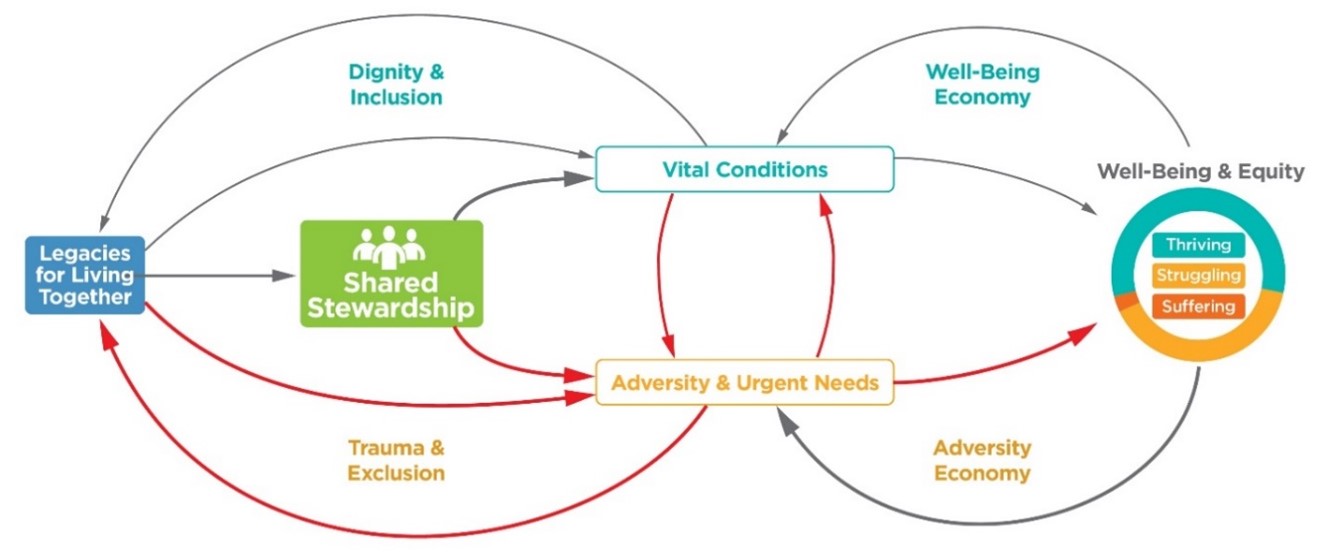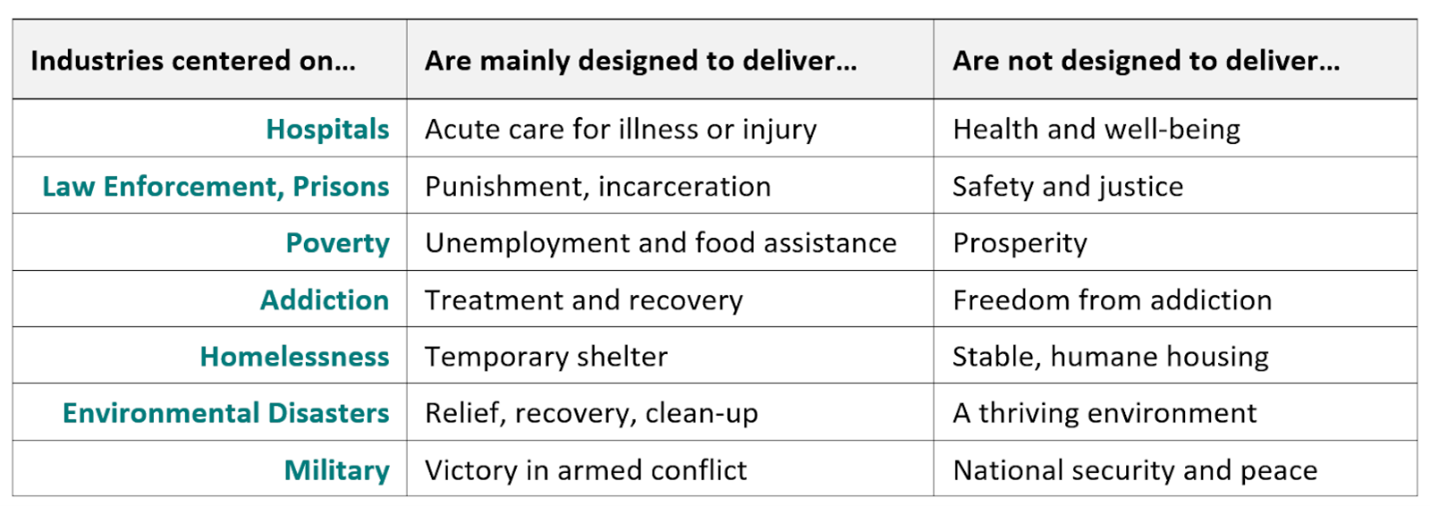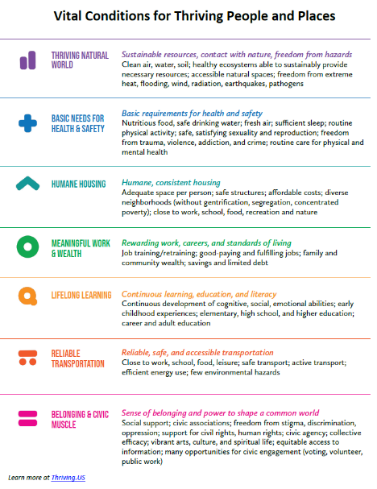By Bobby Milstein
On December 12, 2020 a group of White nationalists destroyed the Black Lives Matter banner in front of the Metropolitan African Methodist Episcopal Church in Washington, DC.
The church pastor, Rev. William H. Lamar IV, experienced the incident as the latest expression in America’s long struggle with racist violence. He also offered a poignant solution:
“Those who ripped down our sign — whether they are aware of it or not — suffer from kleptocratic, crony capitalism. What they really want is a new narrative and a new politics. What we must do is the hard work of creating this new narrative — one that tells a true story of humans thriving together and sharing the abundance of the land and their labor.”1
A growing movement of fellow Americans shares Rev. Lamar’s understanding that American renewal gains force when we organize around the expectation of all people and places thriving—no exceptions. For instance, in response to the compounding crises of 2020, more than 100 people and organizations (including me) embraced that same idea when we created, Thriving Together: A Springboard for Equitable Recovery and Resilience in Communities Across America.2
Like Rev. Lamar, the Springboard seeks to convert loss into renewal by shifting America’s current form of unjust capitalism into an economy that is organized around the basic goal of thriving together. It asks us to, “imagine America’s economy at its best: just, regenerative, multiracial, valuing all stakeholder interests, with rebalanced power and devotion to the long view of what people and places need in order to thrive.”
What will it take to bring that vision of economic renewal to life in communities across America? This paper explores the positive forces that could be unleashed if our economic life were truly oriented around the north-star goal of thriving together. Doing so will require a macro-shift (a sweeping transformation in vision, values, and actions), but it is nevertheless within reach – in fact, in a world fraught with escalating threats, all of our lives and livelihoods depend on it.3
Reorienting Values & Markets
Economic markets in America and around the world currently reward many things that undermine well-being and drive demand for urgent services. We do not place nearly enough value on the vital conditions that actually produce the experience of thriving.
To achieve that benefit, we must position our values for well-being and justice more prominently in our lives and in our markets. The task before us is to rebalance the primary focus of America’s economy from merely enduring and alleviating adversity to expanding well-being (compare the bottom and top halves of Figure 1).
Figure 1: Dynamics of Thriving Together

Source: Bobby Milstein, Jack Homer, Monte Roulier, et.al., “WIN Network Theory of Change & Action Plan: What Does It Take to Secure Legacies of Intergenerational Well-Being for All” (December 27, 2019), https://tiny.cc/WINTheory
What Drives Thriving, Struggling, and Suffering?
As unique people in a common world, we each inherit–and can either continue or replace–legacies for living together. Legacies that honor everyone’s dignity and inclusion strengthen a mutual sense of belonging and civic muscle, which is both a vital condition unto itself and a pragmatic necessity for success in any effort to thrive together. Each step toward dignity and inclusion brings us closer to creating a thriving commonwealth.
By contrast, legacies that favor some people while inflicting trauma and exclusion on others do the opposite. Think of structures like racism or sexism, for example, that are reinforced over centuries. Those schemes are ultimately self-defeating: they deny our shared need for belonging, erode civic muscle, and dehumanize both the beneficiaries as well as those who bear the burdens. As a practical matter, they amplify adversity and increase the number of people who are struggling and suffering.
Over the last 50 years, an adversity spiral—propelled by eroding vital conditions and by ongoing legacies of trauma and exclusion—has ballooned into a full-fledged adversity economy. The practical consequence is that communities across America are pouring ever-more resources into large, intertwined industrial complexes centered around hospitals, prisons, poverty, addiction, homelessness, environmental disasters, and the military.4
At their best, these industries alleviate adversity and employ millions of people who routinely save lives. But their business models depend on a steady flow of affliction. Typically stretched thin and unable to reduce rising demand, urgent service industries are not designed to deliver the full value that we seek for well-being and justice (see Table 1).

Table 1: Design Features of Urgent Service Industries
All communities must maintain a network of well-equipped, well-connected urgent services. Indeed, because of their indispensable, life-altering value, the entire urgent service enterprise ought to be as effective, equitable, and efficient as possible. At the same time, it is unwise to over-rely on urgent service industries because the sheer burden of having so many struggling and suffering people creates an unnecessary drag on any community’s potential to thrive.
Worse, over-reliance on an adversity economy fuels the mistaken mindset that the best we can do is to keep up with escalating affliction. That cynical view denies the premise that all people ought to be thriving. It asserts that temporary services are enough for those who are struggling and suffering, especially when precious resources go toward people who are perceived as “other.” That inhumane attitude is doubly damaging: it further harms those already in pain, and it locks us all in a self-defeating adversity spiral.
The American economy is now about $20 trillion per year, roughly four and a half times larger than all government budgets, and 40 times larger than all philanthropy.5 If even a fraction of our mainstream economy were to focus on producing the vital conditions that everyone needs to thrive together, it could open a new era of economic and democratic innovation.
Progress will remain slow, however, until our economy as a whole–and those who hold the purse strings in every community–invest resources to unlock the trapped potential for all people and places to thrive—no exceptions. Fortunately, there are signs that America may be moving (albeit slowly) toward a well-being economy: one where incentives for just purpose and profit focus on producing the vital conditions that we each need to thrive. Responding to alarming levels of wealth inequity and other flaws in the current economic system, many system stewards, including entities as diverse as the U.S. Surgeon General and Imperative 21, a network of companies and individuals seeking economic change, are reimagining capitalism to be more just and challenging every business to compete on their ability to generate sustained value for people and planet.6-8
The Springboard poses two “legacy questions” for renewing economic life:
- How can we be midwives to an emerging well-being economy?
- How can we co-create local economies that routinely produce all of the vital conditions we need to thrive?
Everyone in America, in every walk of life, can participate in answering those questions for themselves and for the people and places we love.
Bobby Milstein is Director of System Strategy at ReThink Health (a Rippel initiative) and Visiting Scientist at MIT’s Sloan School of Management.
References
1 William H. Lamar IV. “My Church Will Replace Our Black Lives Matter Sign. Will America Replace Its Racist Myth?” Washington Post, December 15 2020. https://www.washingtonpost.com/opinions/2020/12/15/dc-metropolitan-ame-church-vandalized-blm-sign/.
2 Bobby Milstein, Monte Roulier, Elizabeth Hartig, Christopher Kellerher, and Stacy Wegley, eds. Thriving Together: A Springboard for Equitable Recovery and Resilience in Communities across America: Well Being Trust, 2020. https://Thriving.US.
3 Ervin Laszlo. Macroshift: Navigating the Transformation to a Sustainable World. San Francisco, CA: Berrett-Koehler Publishers, 2001.
4 Bobby Milstein, and Jack Homer. “Which Priorities for Health and Well-Being Stand out after Accounting for Tangled Threats and Costs? Simulating Potential Intervention Portfolios in Large Urban Counties.” The Milbank Quarterly (February 6 2020): 1-27. https://onlinelibrary.wiley.com/doi/abs/10.1111/1468-0009.12448.
5 Paul Tudor Jones. Yahoo Finance Presents: Paul Tudor Jones. Yahoo! Finance (December 3 2020). https://finance.yahoo.com/video/yahoo-finance-presents-paul-tudor-161723764.html.
6 WIN Network. “Win with Business: The Role of Business in Advancing a Thriving and Just Nation: A Conversation with the Surgeon General, Jerome M. Adams.” November 20 2020. https://tiny.cc/WIN-SG-110220.
7 Anna Muoio, Amit Bouri, and Chris Jurgens. “Aligning Action to Reimagine Capitalism.” National Civic Review (January 22, 2021). https://www.nationalcivicleague.org/ncr-article/aligning-action-to-reimagine-capitalism/
8 Bobby Milstein, Pedja Stojicic, Ella Auchincloss, and Chris Kelleher. “Civic Life & System Stewardship on the Job: How Can Workers in Every Industry Strengthen the Belonging and Civic Muscle We All Need to Thrive?”. The Good Society (in press).




